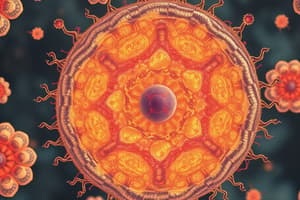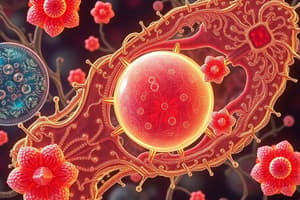Podcast
Questions and Answers
What is the significance of the cell theory in biology?
What is the significance of the cell theory in biology?
- It states that all cells can produce their own energy.
- It defines that all living organisms are composed of cells and that they arise from pre-existing cells. (correct)
- It highlights that cells are only formed in multicellular organisms.
- It asserts that cells can only replicate under specific environmental conditions.
Which of the following accurately describes the processes involved in molecule movement across cell membranes?
Which of the following accurately describes the processes involved in molecule movement across cell membranes?
- Diffusion occurs when molecules move against the concentration gradient.
- Osmosis refers to the movement of solutes from low to high concentration.
- Active transport involves the movement of substances through a semi-permeable membrane.
- Diffusion is the passive movement of solutes from high to low concentration. (correct)
What role do organelles play in a cell?
What role do organelles play in a cell?
- They primarily serve to protect the cell from external threats.
- Organelles are structures that can survive independently of the cell.
- They contribute to various cellular functions such as nutrient intake and waste removal. (correct)
- Organelles are responsible for energy production only.
What best describes osmosis in biological systems?
What best describes osmosis in biological systems?
Which statement correctly explains the kinetic molecular theory as it relates to diffusion?
Which statement correctly explains the kinetic molecular theory as it relates to diffusion?
What distinguishes a hypotonic environment in relation to a bacterial cell?
What distinguishes a hypotonic environment in relation to a bacterial cell?
Which of the following statements about the cell wall and vacuoles is accurate?
Which of the following statements about the cell wall and vacuoles is accurate?
Which role does ribosomal RNA (rRNA) play in cells?
Which role does ribosomal RNA (rRNA) play in cells?
What is the primary function of the nuclear pores?
What is the primary function of the nuclear pores?
In what way does the concentration of water in animal cells adjust to prevent harmful effects from osmotic pressure?
In what way does the concentration of water in animal cells adjust to prevent harmful effects from osmotic pressure?
Flashcards
Diffusion
Diffusion
The process by which molecules tend to move from a region of high concentration to a region of low concentration. This is driven by the constant motion of molecules and collisions between them.
Osmosis
Osmosis
The movement of water molecules across a semi-permeable membrane from a region of high water concentration to a region of low water concentration.
Cell
Cell
The basic unit of life. All living organisms are made of cells.
Organelle
Organelle
Signup and view all the flashcards
Cell Theory
Cell Theory
Signup and view all the flashcards
Hypertonic
Hypertonic
Signup and view all the flashcards
Isotonic
Isotonic
Signup and view all the flashcards
Hypotonic
Hypotonic
Signup and view all the flashcards
Cell Wall
Cell Wall
Signup and view all the flashcards
Study Notes
Cell Structure and Function
- Life characteristics include a defined lifespan, growth, reproduction, energy requirements, and waste production, as well as repair.
- All living organisms are composed of cells, the basic organizational units.
- Cells arise from pre-existing cells.
- Cells come in two types, eukaryotic and prokaryotic.
- Eukaryotic cells are generally larger and are common in multicellular organisms.
- Prokaryotic cells are smaller and have fewer organelles compared to eukaryotes.
- Organelles are structures within a cell that carry out functions to maintain life, and many organelles have specific functions.
- These organelles include, but are not limited to, the Cell membrane, Cytoplasm, Nucleus, DNA, Vacuoles/Vesicles, Mitochondria, Lysosomes, ER and Ribosomes, Golgi apparatus and Cytoskeleton.
- The cell membrane acts as protection and helps move substances in and out of the cells.
- The cytoplasm is the jelly-like substance that fills the cell, holding the organelles and nutrients.
- The nucleus is the control center that manages cell activities and contains DNA.
- DNA holds coded information for protein synthesis.
- Vacuoles and vesicles are membrane-bound sacs that store various substances including water, waste, and nutrients.
- Mitochondria are responsible for converting nutrients into energy for the cell.
- Lysosomes break down waste materials and damaged organelles.
- The endoplasmic reticulum (ER) and ribosomes work in protein production.
- The Golgi apparatus modifies, sorts, and packages proteins and materials.
- The cytoskeleton maintains cell shape and facilitates movement.
DNA and Genes
- DNA is the deoxyribonucleic acid, a crucial molecule that carries genetic instructions.
- DNA's structure is a double helix made up of nucleotides.
- The order of nucleotides in DNA forms a code that dictates protein production.
- Genes are segments of DNA responsible for specific traits, and can be passed down through generations.
- Chromosomes are large DNA molecules with segments of DNA that control various activities.
- Four types of nucleotides are adenine, thymine, cytosine, and guanine.
- These form pairs, and these pairs are on opposite sides to one another naturally.
- The order of these nucleotides in the DNA forms the specific sequence and determines the order of amino acids, thereby determining the protein.
Cell Cycle
- The cell cycle is a series of events that describes a cell's lifetime from formation to reproduction.
- Interphase is the preparatory phase where the cell grows and replicates its DNA.
- Gap 1 (G1), Synthesis (S), and Gap 2 (G2) are phases of the cell cycle
- Mitosis is the division of the nucleus followed by cytokinesis, which divides the rest of the cell.
- Mitosis is further composed of prophase, metaphase, anaphase, and telophase
Cancer
- Cancer is a disease caused by uncontrolled cell division.
- Factors such as lifestyle choices, genetic predisposition, and environmental factors (carcinogens) contribute to cancer development.
- Diagnostics methods including but not limited to blood tests, urine tests, X-rays, CT scans, ultrasounds, PET scans, X-rays and MRIs can help detect cancer cells.
- Treatments include surgery, chemotherapy, and radiation therapy,.
- DNA damage, uncontrolled division, DNA mutation can lead to cancer.
Stem Cells and Tissue Types
- Stem cells are a type of unspeicialized cell in the body that can produce specialized cells.
- Embryonic stem cells have more potential for differentiation, meaning they can develop into more cell types compared to adult stem cells.
- Adult stem cells have a more limited capacity for differentiation and are found mainly in specific regions, such as the bone marrow.
- Stem cells play a important role in tissue repair and regeneration.
- Epithelial tissue is the primary tissue that protects and lines cavities and organs.
- Connective tissue provides structure, support, and protection in various parts of the body.
- Muscle tissue is responsible for movement, and Nervous tissue is essential for communication and coordination in the body.
Plant Structures
- Plant tissues comprise meristematic, epidermal, ground, and vascular.
- Meristematic tissue is for growth.
- Epidermal protects the plant.
- Ground tissue fills space, and vascular tissue performs transport (xylem & phloem).
- Rooted tissues consist of xylem, phloem, cambium and epidermal.
Studying That Suits You
Use AI to generate personalized quizzes and flashcards to suit your learning preferences.




